This was published 5 years ago
Call of the wild: listen up, people, time is running out
For decades, humans have been ignoring Mother Nature’s warnings about the future of the planet. Exactly how loudly does she have to scream?
By David Leser
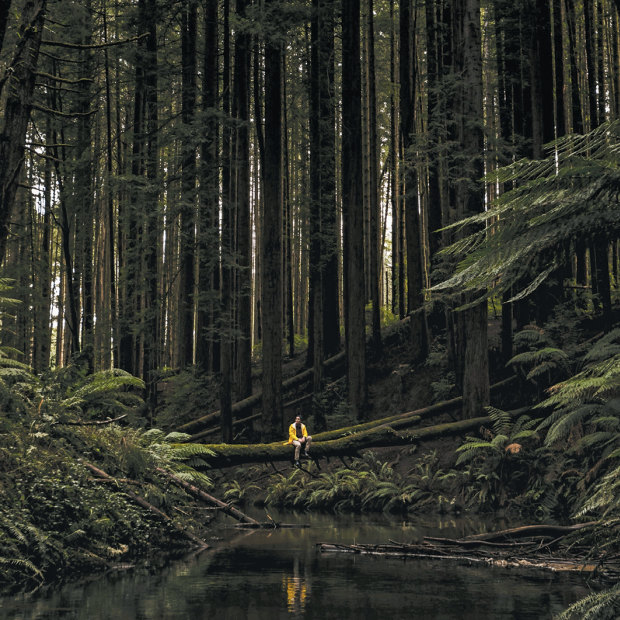
Wilderness in Victoria. In the words of David Attenborough: “We depend upon the natural world for every mouthful of food we eat and every lungful of air we breathe.”Credit: Getty Images
Daughter: “Mummy, what’s that smell?”
Mother: “It’s nature, darling.”
Daughter: “It’s like all the birds are wearing perfume.”
You notice these things when you’re young, or still capable of retaining a childlike sense of wonder, or you find yourself, as I do one day, in an enchanted forest while great stretches of the country are burning.
You notice nature’s perfume and all its physical, fairy-tale qualities. You see giant mountain ash soaring 70 metres up into the light, along with blackwoods, candlebarks, stringybarks and every kind of tree fern growing at right angles out of the wire grass and undergrowth. You smell a wet forest of needles and frass, of nutrient-rich soil, rotting wood and creeping moss, and as you smell and see all this, you feel – or, at least, I do – that you’re sensing it for the first time, perhaps even the last.
I happened to be in the Yarra State Forest in central Victoria when I heard that daughter’s question to her mother, although it sounded to me more like a supplication. Mummy, what’s that smell?
It was early in the new year and I was bathed in more greens than I could count or identify – jade, lime, olive, bottle, emerald – all of nature’s special effects on display. Meanwhile, to the east, west, north and south of me, tens of thousands of people were being evacuated, towns were being
engulfed by rolling waves of flame, smoke and radiant heat; lives, homes and treasured keepsakes were being lost, more than one billion animals were being vaporised – dying creatures everywhere – and birds, tens of millions of king parrots, crimson rosellas, lorikeets, kookaburras, whip birds, bower birds, every type of wattlebird, black cockatoos, white cockatoos, galahs, were dropping from the heavens.
It seems like a lifetime ago now, these events that many of us could never have imagined occurring: the very cycle of life on fire and the Australian bush – that place of primal, mythical power in our consciousness, filled with all its shades of colour and light, alive to the music that had been scored and produced by the songbirds of the world for millions of years – about to fall into a deathly hush.
During this past black summer, like most of us, I’d choked on smoke, sweltered in unbearable heat, feared for a multitude of friends, sat transfixed to the news and my bushfire emergency apps, changed and re-changed travel plans, grappled with my own fear, grief, trauma and incandescent rage. And all this before a pestilence had begun sweeping the world and upending our lives in new unthinkable ways.
Over the summer I’d also read a number of books (what else was there to do when going outside was a health hazard?) including The Overstory by Richard Powers, which had got me thinking about trees and forests in new ways. Not just the basic facts of how they create soil, store and cycle water, trade nutrients, generate humidity, build weather systems, and conjure up the very miracle we call photosynthesis. Not just the elemental truth of how they breed, feed and shelter all creatures great and small, even – as the Buddha once said – the axeman who comes to destroy them.
Not just because they play host to hundreds of thousands of species of insects and millions of microbes and invertebrates, while also providing us with fats, sugars, waxes and wonder drugs, along with cradles, coffins, cabinets, balconies and homes. I’d understood something of that already, but what I’d never understood before was how trees actually communicate with each other, through the air and via an underground trading system of roots, bacteria and fungal threads that has come to be known as the Wood Wide Web.
First Nations people have always known – or intuited – this mysterious information flow. They’ve had a dialogue with nature for tens of thousands of years because, in their cosmology, the earth was never mindless or impersonal, it was a sentient life force woven into everything. Humans lived on the land, but the land also lived and breathed inside us, and there was moral reciprocity to this relationship. The mountains talked, the rivers whispered, the land remembered, and this dialogue with the natural world was far more than a matter of physical survival. It was a source of emotional and spiritual sustenance, one that we – in our industrial, urban hunger – had failed to register.
This was what Artemisa Xakriabá, the 19-year-old climate activist from Brazil, was speaking to at a climate strike in New York last year: “We, the Indigenous Peoples, are the children of nature so we fight for our Mother Earth because the fight for Mother Earth is the mother of all fights. We are fighting for your lives. We are fighting for our lives.”
And now, in this fearful Australian summer – which was about to morph into a different but equally fearful autumn – I was discovering, through my reading of Richard Powers’ The Overstory, alongside Peter Wohlleben’s The Hidden Life of Trees, what scientists had long been investigating: the ways in which the earth speaks. Roots and plants link together through a subterranean network of living fungal threads called mycorrhiza; trees pool resources, feed each other, build immune systems, keep their young and sick alive, forge alliances, deter attacks and send warnings to other trees. And they operate at frequencies way too low for us to hear, co-operating through a secret language of scent and electrical signalling.
“One reason that many of us fail to understand trees is that they live on a different time scale than us,” observed renowned conservationist and former Australian of the Year Tim Flannery in the foreword to Wohlleben’s book. “One of the oldest trees on Earth, a spruce in Sweden, is more than 9500 years old … Creatures with such a luxury of time on their hands can afford to take things at a leisurely pace.
The electrical impulses that pass through the roots of trees, for example, move at the slow rate of one third of an inch per second. But why, you might ask, do trees pass electrical impulses through their tissues at all? The answer is that trees need to communicate, and electrical impulses are just one of their many means of communication.”
Flannery also argued that trees used their sense of smell and taste for communication. If a giraffe starts nibbling, say, an African acacia, the tree will release a chemical into the air that signals an imminent threat. As the chemical wafts through the air and reaches other trees, these trees “smell” it and are warned of the danger. Even before the giraffe reaches them, the trees have begun manufacturing toxic chemicals as a defence.
“But the most astonishing thing about trees,” Flannery wrote, “is how social they are. The trees in a forest care for each other, sometimes even going so far as to nourish the stump of a felled tree for centuries after it was cut down by feeding it sugars and other nutrients, and so keeping it alive.”
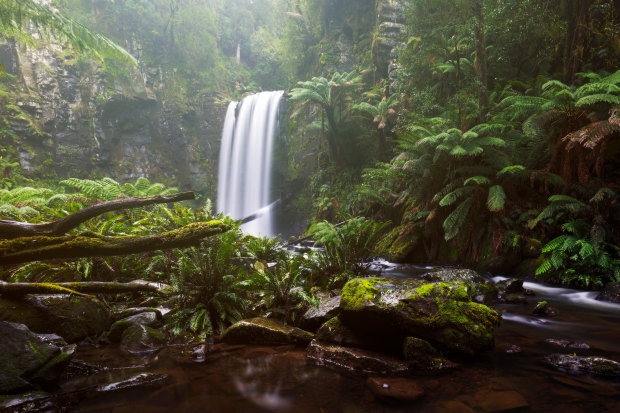
Wilderness in the Great Otway National Park in Victoria. “One of our main tasks now … is to understand this moment, what it might require of us," says American writer Rebecca Solnit. Credit: Getty Images
I thought of all this as I heard that little girl’s question in the Victorian forest. I thought about the firestorms that were roaring across ridges and valleys, climbing over mountains and destroying communities with Hiroshima-like heat, incinerating millions of hectares across five states and 91 local government areas.
I thought of the Gondwana rainforests near where I’d once lived in northern NSW – all those brushbox, turpentine and coachwood that had never burnt and should never have been burning – and I thought, too, of the estimated 15 billion trees that had been cleared in the Murray-Darling Basin since white settlement, and how loggers – right now – are taking their chainsaws into burnt and unburnt native forests for pulp and woodchip, even though the evidence shows overwhelmingly that logged forests burn at much higher severity than those left alone.
“Loggers are demanding access to national parks to cut burnt trees, not understanding the very forests they’ve been working in and the fact that they’re already starting to resprout,” Professor David Lindenmayer from the Australian National University’s College of Science tells Good Weekend.
“[Yes] the trees have been burnt, but the trees have not been killed. The tree ferns have been burnt but they haven’t been killed and they’ll start throwing out fronds, and the same with the palms. And there’s a seedbank in the soil, so even though the leaf litter has been burnt and the soil has been burnt, the smoke and the fire associated with these burns will trigger a pulse of germination as well as a pulse of resprouting and regrowing.
“That’s why it it’s really important often to leave these ecoystems to recover, rather than responding to the call of the timber industry to cut them down because they’re burnt.”
I had another thought, too, a strange one. I remembered a Roald Dahl book I’d read in my childhood called The Sound Machine, in which the protagonist, a man called Klausner, takes an axe to a tree and sinks it into the wood flesh. At that same moment, through his earphones, he hears a low-pitched screaming coming from the tree, which then turns into a heart-rending sob.
He touches the edges of the tear in the wood and says, “Tree … oh tree … I am sorry … I am sorry.”
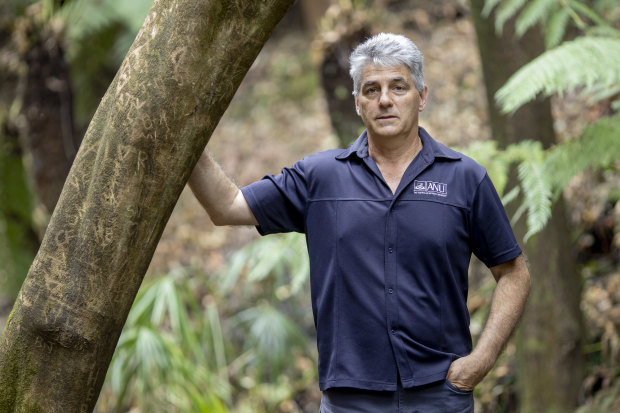
ANU professor David Lindenmayer says it’s vital bushfire-ravaged ecosystems are left alone to recover.Credit: Sitthixay Ditthavong
We mourn the people, animals and places we’ve known and loved, but, perhaps, we also mourn the things we’ve never known, the things we’ve never understood were ours to lose.
Like 50 per cent of the people on this planet (over the next few decades it will become 75 per cent), I have lived most of my life in the city. Despite the privileges of growing up in a physically blessed metropolis such as Sydney, I was never exposed to a true nature-based childhood, certainly not one that harmonised me to the seasons, or reminded me of how, in David Attenborough’s words, “We depend upon the natural world for every mouthful of food we eat and every lungful of air we breathe.”
The world’s most prominent natural historian hadn’t understood this himself when he first started studying biology in the 1940s. Nor had The Hidden Life of Trees author Peter Wohlleben, who, decades later, began working as a forester in Germany before coming to understand the secrets a forest can reveal. “When I began my professional career as a forester,” he wrote, “I knew about as much about the hidden life of trees as a butcher knows about the emotional life of animals.”
But we know now that everything depends on everything else, that the world is an interdependent living system, much as British scientist James Lovelock described when he first developed his Gaia theory in the early 1960s. A potoroo (along with other marsupials) feeds on a truffle which grows on the roots of a tree. No tree, no truffle. No truffle, no potoroo. No potoroo, no ecosystem. Similarly, a virus jumps from a wet animal market in China and, within months, the world we’d known is no longer.
“The entire range of living matter on Earth, from whales to viruses and from oaks to algae, could be regarded as constituting a single living entity capable of maintaining the Earth’s atmosphere to suit its overall needs and endowed with faculties and powers far beyond those of its constituent parts,” Lovelock wrote in 1979 in his book Gaia: A New Look at Life on Earth. And then, more than a quarter of a century later in a speech in Paris: “We have to stop thinking of human needs and rights alone. Let us be brave and see that the real threat comes from the living earth, which we have harmed and is now at war with us.”
So choose your point of entry into this story. I chose forests and birds. I could have chosen soaring temperatures, choking oceans, dying rivers, melting ice caps, rising sea levels, disappearing wetlands, bleaching coral reefs, putrefying air, multiplying freak weather events, the unravelling of entire ecoystems.
This “great, spoked, wild, woven-together place beyond replacing”, as Richard Powers wrote when describing this planet that has been here for 4.5 billion years, and which we have managed to nearly destroy in 50. We didn’t do this because we wanted to, but because we didn’t understand, or refused to understand, that in reshaping the Earth as a global industrial economy, we would be severing our kinship from nature. And that nature, being what she is, would ultimately fight back.
For months I could barely bring myself to write this story. What use another account when so much had already been written, often brave and beautifully penned testaments to a hellscape summer? How to give voice to a grief that seemed to go well beyond the personal, well beyond all our broken, traumatised communities and destroyed habitats, right down deep into something like the very essence of life itself?
As I listen now to David Ritter, chief executive of Greenpeace Australia, I can almost hear the earth crying to be rescued, and all our children and grandchildren with it. “The first thing you notice in the morning is breath,” he tells me on a day fires are raging out of control in the Namadgi National Park, south of Canberra, and temperatures are climbing to 45 degrees in western Sydney. “And it is the first thing you look for in your own child when they’re born. Apart from those two breaths, breaths that you notice in life are those that are shared by life itself.
“So they’re the breaths that you take when you are in the ocean, or the breaths that you take when you are out of the city. They are the breaths that you take when you can smell the scent of the soil, or the scent of the flowers, or the rising of eucalyptus in this country.
“There is a feeling that you have when the soil is underneath and the sand is – as the brochures say – between your toes … that is not replaceable, that is not redeemable through all the multiple moments of distraction that we fill our days with. At the heart of the crisis of the species and of civilisation is just that deep alienation from that thing which is the source of us and also at the heart of all we love.”
In December last year, Ritter’s seven-year-old daughter asked him if she would now need to wear a mask for the rest of her life. Not long afterwards, her older sister beseeched him, “Daddy, they rescue all the animals first, don’t they?” Ritter hesitated, then told her, “No, they don’t.”
Ritter has degrees in law, history and politics, and is the author of The Coal Truth, a blistering indictment on how the coal industry has distorted Australia’s democratic institutions. At this moment, however, during our interview, he weeps softly as he talks about the collapsing fabric of life, and the failure of both our major political parties to protect us from this.
“I can remember the smell of spring, I can remember the smell of October in the [Perth] foothills where I grew up. And that’s gone. All of those things that we turn to – the eternals – ‘to everything there is a season, turn, turn, turn’ … those things are unravelling as we speak. And the thing that I find just so extraordinary about the likes of [Scott] Morrison and [Anthony] Albanese is that they’re still not reading the signs. If they think this is bad, things can get so very much worse, and will, if we don’t act. You ask about the middle of the night – it’s that unravelling of things.
“The feeling you have when the soil is underneath your toes … is not redeemable through all the multiple distractions we fill our days with.”
David Ritter, Greenpeace Australia chief executive.
“The conditions for catastrophic fires were created by rising emissions, the number one driver of rising emissions is the coal industry and there is no plan for phasing out domestic coal-burning power stations in Australia. There is no plan for dealing with the coal export industry in Australia.”
This still seems vitally important to say, despite the deadly pathogen we are having to grapple with: that in the past half-century, we humans – according to the WWF’s 2018 Living Planet report – have managed to see off as much as 60 per cent of the world’s mammals, birds, reptiles and amphibians, while placing one million plant and animal species under threat of extinction. Through the impact of human activities we have killed half the world’s coral reefs. We have cleared half the world’s tropical forests. We have polluted the oceans, shrunk the Arctic and Antarctic summer ice, caused droughts, heatwaves, desertification, fires, floodings and storms, along with water and food shortages, on an unprecedented scale.
And what elicits so much rage and despair – for people like Ritter, for millions of striking schoolchildren around the world, for the millions of dedicated, exhausted activists who have so often been pilloried for their efforts, for the hundreds of millions of others facing environmental catastrophe – is that we have been warned, repeatedly.
In 1960, American geochemist Charles Keeling concluded after years of research that human activity – mainly deforestation and the burning of fossil fuels – was causing dangerous build-ups of carbon dioxide in the atmosphere. Two years later, American conservationist Rachel Carson published her era-defining book Silent Spring, cautioning that we were contaminating the natural world – indeed, ourselves – with our indiscriminate use of synthetic pesticides, mainly for single-crop farming.
Silent Spring became the inspiration for the ecology movement and, of course, it was attacked mercilessly by the chemical industry and its lobbyists. Carson was denounced – among other things – as a communist sympathiser and “a spinster with an affinity for cats”.
Then, in 1972, the Club of Rome – an international association of leading scientists, economists, former heads of state and business leaders – published its Limits to Growth report, predicting widespread environmental collapse unless we curbed our appetite for ceaseless economic growth.
In the succeeding decades, scientists sounded further warnings, as did long-silenced indigenous voices, land experts, flora and fauna experts, cultural experts and men such as Nicholas Stern, a former World Bank chief economist, who predicted in 2006 a $9 trillion hit to the global economy unless we dramatically reduced carbon emissions. Two years later, Ross Garnaut, one of Australia’s pre-eminent economists, forecast more frequent and devastating fires by 2020 if we failed to reverse course. “If you ignore the science when you build a bridge, the bridge falls down,” he told the ABC in January this year, just as his dire predictions were being realised.
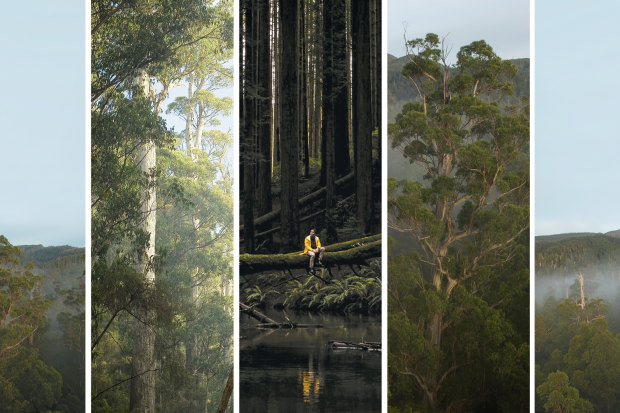
The Styx Valley in southern Tasmania and wildness in Victoria.Credit: Getty Images; Alamy; AAP
World: “There is no way we can shut everything down in order to lower emissions, slow climate change and protect the environment.”
Mother Nature: “Here’s a virus. Practise.”
(Anonymous)
I began writing this story in drought and fire. I paused for a while as the floods came and, then, once the floods had passed and the contagion had arrived, I paused again, this time to consider what it is that actually makes a life worth living.
I thought about my family, friends and neighbours, and about the astonishing array of beauty and suffering there is in this world. I thought about what work is worth doing and what makes for a meaningful life.
I thought about some of the ideas in American academic Theodore Roszak’s 1992 book The Voice of the Earth, and how it might be that many of the ailments people are bringing to their doctors and therapists – their “agonies of body and spirit” – are, in fact, a planetary emergency registering in the most intimate parts of ourselves. “The earth hurts,” he wrote, “and we hurt with it.”
I thought also about how grief claims you when you least expect it, but that, as American writer Terry Tempest Williams says, it also “dares us to love once more”.
So, yes, I’d begun writing this story watching my country on fire, witnessing all the illusions of certainty being exposed, and recognising – not for the first time – how everything we love in this world, we also lose. But as I sit here now in my social isolation, staring into a forest that was saved last summer by a miraculously shifting wind, my main thoughts are: When will I curl up on the couch with my daughters again? Will I be able to hug my 91-year-old mother before she dies? What will happen now to the hundreds of millions of people left destitute around the world?
I don’t know how we as a country are meant to deal with so much trauma in such a short space of time, but at the beginning of this summer, all I wanted to do was speak to a bottomless, righteous rage: rage against our political class. Rage against the fossil fuel industry, the loggers, land clearers and water diverters. Rage towards all the sneering ideologues who – for reasons best known to themselves – have done everything they can to not just belittle science, but to scorn and dismiss the thoughtful, dedicated scientists who would prefer anything than to be proven right about climate change. Rage for all the squandered years when we might have done more to reduce our vulnerability to climate change.
But global catastrophe has a way of making rage alone look churlish and decidedly unhelpful, especially when measured against the countless displays of heroism from frontline workers, and all the random acts of kindness we have witnessed from complete strangers.
“One of our main tasks now,” observed American writer Rebecca Solnit recently – “especially those of us who are not sick, are not frontline workers, and are not dealing with other economic or housing difficulties – is to understand this moment, what it might require of us, and what it might make possible. Change is not only possible, we are swept away by it. We ourselves change as our priorities shift, as intensified awareness of mortality makes us wake up to our own lives and the preciousness of life.
“Even our definition of ‘we’ might change as we are separated from schoolmates or co-workers, sharing this new reality with strangers. Our sense of self generally comes from the world around us, and right now we are finding another version of who we are.”
We are also finding another version of the world around us. Just to drink in joyful images of endangered leatherback turtles returning to Thailand’s southern beaches, Kashmiri goats wandering the streets of northern Wales, tiny shoals of fish swarming in the canals of Venice, not to mention wondrously clear skies above Beijing, New Delhi and Los Angeles, is to see how suddenly reduced carbon emissions can help the natural world repair.
And not before time, because, while the coronavirus has collapsed economies and disordered societies in ways none of us have ever witnessed before, climate change still remains the greatest threat to our future.
“If we do not turn the tide on climate change,” Christiana Figueres, the former United Nations Executive Secretary for Climate Change, tells Good Weekend, “we will be seeing the spread of current diseases to geographic areas that weren’t there before and we will likely be seeing the eruption of new diseases because of the change in temperature. And we are totally unprepared for that. The other piece that worries me a lot is that, predictably, we have this eruption of a new disease and we will have the very tragic fatalities that we’re already seeing, but it is predictable that we will be able to gain control over this and run the clock back on it.
“That is not true of climate change. Once we get to certain tipping points – if we get to those tipping points – and those tipping points begin in 2030 if we don’t cut emissions down to half [by then] … then we walk into a world in which you have this cascade of tipping points of many different ecosystems that makes the increase of the impact irreversible.”
Between 2010 and 2016, Figueres led the negotiations to reach what became the most important climate accord in history – the 2015 Paris Agreement, which established a legally binding framework for an internationally co-ordinated approach to climate change, one requiring all countries to set ambitious targets to limit global warming to 1.5 degrees Celsius above pre-industrial levels. Figueres saw, firsthand, what countries could do when they collaborate.
Now, in an interview in Sydney after receiving a gold medal for human rights from the Sydney Peace Foundation, the co-author of the recently published The Future We Choose makes the case for how the global community can respond to the threats from both climate change and COVID-19.
“There are many similarities between the two,” the Costa Rican-born diplomat says. “One is the big lesson that there is no such thing as a passport or national border when it comes to global issues. A border or a passport is just irrelevant, as it is for climate. The other thing is that we can actually change our behaviour, even in the short term.
“That’s very interesting, because everybody would argue that behaviour change takes a long time. Yet everybody has changed their behaviour. Like that,” she says, clicking her fingers. “It’s also interesting as a reminder that in order to deal with global issues, it cannot be single, isolated efforts in this city, that state or that country. It requires global co-operation in order to bring it under control.”
Two years after the Paris climate talks concluded, the Intergovernmental Panel on Climate Change (IPCC) – the UN body responsible for assessing climate change-related science – called for a revolutionary overhaul of our entire way of life in order to avoid warming of the planet beyond 1.5 degrees Celsius. That would mean a transformation of every sector of the economy – starting now – including how we generate electricity, capture carbon, manage the land, run our transport system, mobilise finance, build and sustain our urban infrastructure, and change our eating habits (less meat, more plant-based diets).
![Former UN Executive Secretary for Climate Change, Christiana Figueres. "Australia has huge potential to be the major [clean] energy generator and power of large parts of the Pacific.”](https://static.ffx.io/images/$zoom_0.3163%2C$multiply_0.5855%2C$ratio_1.5%2C$width_1059%2C$x_98%2C$y_455/t_crop_custom/q_86%2Cf_auto/8beaf24b9193622bbf41c3648fe8b440da451483)
Former UN Executive Secretary for Climate Change, Christiana Figueres. "Australia has huge potential to be the major [clean] energy generator and power of large parts of the Pacific.”Credit: Dominic Lorrimer
No one would deny the enormity of these challenges, particularly for a country such as Australia whose reliance on fossil fuel exports has grown exponentially since the oil shocks of the 1970s. Today, Australia is the largest coal (and liquefied natural gas) exporter in the world and, on a per capita basis – according to the International Energy Agency (IEA) – the second-highest emitter of fossil fuels in the world, second only to Saudi Arabia and higher than the United States.
According to the Climate Council – an Australian non-profit organisation comprising some of the country’s leading climate scientists and policy experts – Australia would, therefore, need to leave 90 per cent of its coal in the ground if it was to play its part in limiting global warming to no more than 2 degrees Celsius. That idea causes near apoplexy for those wedded to the idea that Australia is economically doomed without a fossil fuel-reliant export industry. According to the Climate Council, however, limiting global warming to this amount – a goal Australia shares with 194 other countries – opens up new and rich opportunities for the Australian economy.
“For example, many of Australia’s coal-fired power plants are inefficient and nearing the end of their lifetimes,” a Climate Council report stated in 2015, “while concurrently the costs of renewable energy technologies such as rooftop solar and wind continue to fall. Work by ClimateWorks Australia and the Australian National University shows Australia can decarbonise the economy with little or no cost through energy efficiency, low-carbon electricity (renewables, nuclear and carbon capture and storage), and electrification and fuel switching (from petrol to electricity or biofuel).”
According to a study by the Australian Energy Market Operator released in April, Australia already has the technical capability to safely run three-quarters of its power grid from wind and solar within five years, if necessary changes to the way we operate and regulate our electricity markets are put into effect.
Add to that the fact that a global movement – inspired by youth-led climate strikes – has seen banks, sovereign wealth funds, global asset managers, insurance companies, pension funds and cities around the world divest a staggering $US11 trillion from the fossil fuel industry in the past six years, and the economics of fossil fuels has never looked more dubious. And that was before the coronavirus pandemic triggered an unprecedented collapse in demand for fossil fuels, prompting the IEA to conclude that renewable energy was the only resilient and economically viable energy source for the future.
As the Climate Council pointed out in a further report in 2017: “Australian businesses are becoming world leaders in climate change action. In fact, Australia has the highest value of fossil fuel divestments per capita of any developed nation on the planet. Many of Australia’s financial institutions have joined the movement, with 53 banks and credit unions in Australia having publicly divested from fossil fuels.” (Only last month, investors demanded that energy giant Woodside commit to bolder targets in limiting direct emissions and end-user emissions.)
Around the world there are signs of progress. India, for example, has emerged in recent years as a global leader in the renewable energy market. Costa Rica has pledged to become 100 per cent renewable by 2021. Britain last year declared “an environment and climate emergency” and passed laws committing the country to net zero emissions by 2050. Germany has pledged to end its reliance on polluting coal power stations by 2038.
The pressures are growing and they present Australia with new ways to imagine itself in the wake of the devastating fires and global pandemic. As this story was going to print, the Morrison government was unveiling a “technology investment roadmap” that seemed to be backing away from coal but not carbon, and relying instead on a major expansion of the country’s gas industry over the next few decades, despite the dramatically falling gas and oil prices caused by the pandemic. It also flagged the importance of negative emissions technologies like carbon capture and storage, but without any emissions trading scheme or pledge to achieve net zero emissions by 2050, the target set by the Paris Agreement. The federal government – unlike the state governments – still refuses to commit to this target.
In a dramatically altered global energy landscape, should we remain wedded to any non-renewable sources of energy, be they coal or gas, or should we choose the kind of future that Christiana Figueres, the former United Nations climate change executive, sees as our destiny?
“This is a huge opportunity,” Figueres tells Good Weekend, “to make a major turnaround and realise that Australia is definitely a very vulnerable country [to climate change]. But it is also incredibly blessed with many of the resources to solve this problem. I understand that Australia only emits 1.3 per cent of global emissions, but luckily the benefits of addressing climate change will not be capped to their relative percentage point of emissions. If Australia were only in for 1.3 per cent of the benefits, then maybe it’s not worthwhile. But Australia can benefit 100 per cent from the turning around of this policy because of the huge potential that Australia has to be the major [clean] energy generator and power of large parts of the Pacific.”
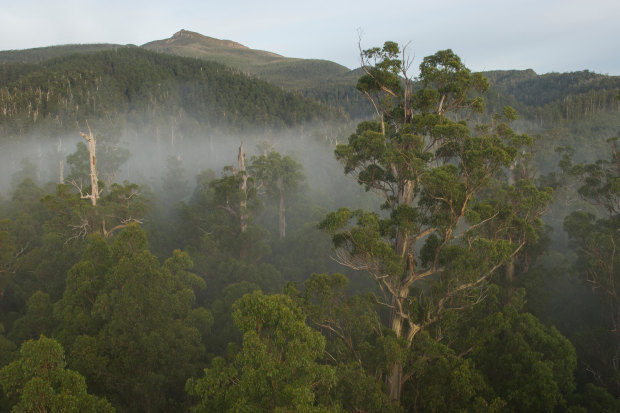
The Styx Valley in southern Tasmania. Without climate action by 2030, “we walk into a world in which you have this cascade of tipping points of many different ecosystems,” says former UN climate chief Christiana Figueres.Credit: Alamy
Last month, The New York Times published a glowing account of how Australia and New Zealand had managed to suppress the coronavirus, thus far. The newspaper’s Australian bureau chief Damien Cave extolled the virtues of both countries’ leaders, Scott Morrison, a conservative Christian, and Jacinda Ardern, the “darling of the left”, for offering a model for recovery that elevated bipartisanship and respect for scientific expertise over narrow-minded political point scoring. He noted, by comparison, the chaos that had marked the Trump administration’s approach to the pandemic.
“It all started with scientists,” Cave wrote. “In Australia, as soon as China released the genetic code for the coronavirus in early January, pathologists in public health laboratories started sharing plans for tests. In every state and territory, they jumped ahead of politicians.”
For decades, scientists (and business leaders, regulators and the community at large) have been ahead of politicians on the issue of climate change, but unlike with COVID-19, scientists’ warnings have often been derided in Australia by those seeking to weaponise climate policy. Yet as Christiana Figueres and co-author Tom Rivett-Carnac point out in their book The Future We Choose, “The science of climate change is not a belief, a religion, or a political ideology. It presents facts that are measurable and verifiable.”
They argue that if we don’t act to cut emissions – by half over the next decade, then to net zero emissions by 2050 – we will have reached a point of no return. The Great Barrier Reef will have become “the largest aquatic cemetery in the world”. Summer Arctic sea ice will have vanished, coastal cities around the world will have been inundated by rising waters, the maps of the world will have been re-drawn, and hundreds of millions of environmental refugees will be scouring the earth for higher ground.
But there is an alternative world they invite us to conceive, one which climate scientists, climate justice groups, think tanks, activist movements, the European Union, the UN (through organisations such as Earth Champions) have been advocating for years, and which New York Congresswoman Alexandria Ocasio-Cortez gave voice to last year when introducing the Green New Deal resolution to the US Congress.
Notwithstanding the enormous challenges, it is a world where we thank fossil fuels for the economic riches they’ve given us, then bid them goodbye. It is a world where almost all our energy requirements come from renewable sources and where 900 million hectares across the world have been reforested, where single-use plastics have been banned, where depleted topsoils have been restored, and where unsustainable farming practices have been replaced with methods that regenerate the soil. It is a world where the industrial slaughter of animals has been checked, where coral farming has returned damaged reefs to something close to their original state, where people take public transport, ride bicycles or share electrical cars, and where every building, certainly in Australia, has a rooftop solar panel, a rainwater tank and a vegetable or flower garden.
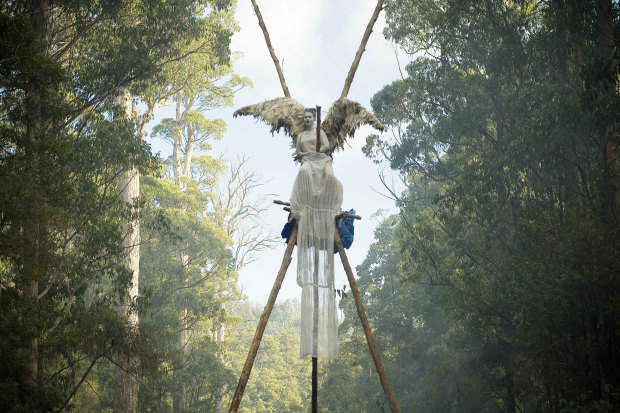
Artist Allana Beltran protesting against the logging of an old-growth forest in southern Tasmania in 2007. “I was ready to sacrifice myself to this cause,” she said. Credit: Matthew Newtown/ AAP
Just over a decade ago, on a mild Australian summer morning, I entered the Styx Valley – or Valley of the Giants – in southern Tasmania for the first time. In front of me was a prehistoric wilderness of eucalyptus regnans, the tallest hardwood trees in the world, towering above a forest floor blanketed in bracken and soft ferns. Among those trees was a mighty regnan known as “Gandalf’s Staff”, soaring nearly 85 metres into the sky, a girth roughly the size of a cliff face.
Five years earlier, this patch of pristine rainforest had been the scene of a remarkable international protest after having been earmarked for destruction. Activists had gathered to establish the Global Rescue Station – a tree-sit suspended just underneath the crown of Gandalf’s Staff. Ben Morrow had been among the protesters. “It was a beautiful place to live,” he told me. “I was there for about eight months and at one time I slept on a platform 75 metres off the ground. I had black cockatoos flying around me.”
A few years later, Morrow took part in another protest, this time in the lower Weld Valley, to try to protect old-growth forests from being clear-felled. That’s where he met his future partner, Allana Beltran, a visual artist, who was about to enter Tasmanian folklore by attaching herself to a giant tripod at the entrance to the forest, wearing wings of white cockatoo feathers and a long white curtain wrapped around her waist, and her face painted white.
She became known as the Angel of the Forest after police arrested her and charged her with committing a nuisance and failing to obey a police instruction. “I did it because I thought it would look beautiful,” she told me at the time, “and if I was going to be arrested as a visual artist, I wanted to make a visual statement … I was praying for the forests and for people to realise what they are doing. I was ready to sacrifice myself to this cause. I was ready to stand up for these ancient forests.”
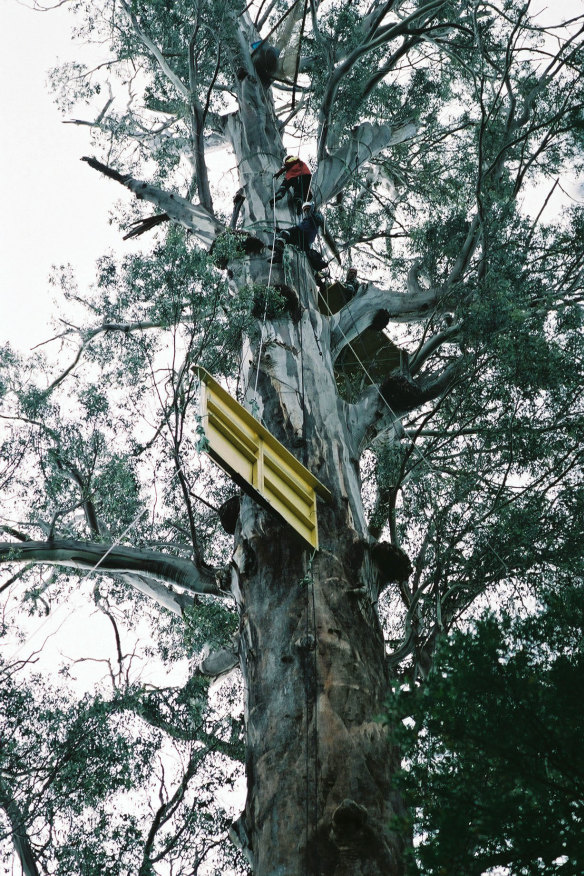
Activists in “Gandalf’s Staff”, an 85-metre hardwood tree in southern Tasmania’s Valley of the Giants.Credit: AAP
I have often asked myself since then, and more so today: “What would I do for nature? What is the single best thing I could do for tomorrow’s world?” Would I stand before a tree that had survived the epochs, only to now be facing the logger’s chainsaw? Would I lift a finger for, say, the endangered sandpiper who, for millions of years, has been refining its 13,000-kilometre flight path from the Arctic Circle to the coastal wetlands of Toondah Harbour in Queensland’s Southern Moreton Bay, only to find its mudflats slated for a marina and 3000-apartment residential complex?
Would I stop buying my oranges from California and buy them instead from my local farmers’ market because I finally understand how the worst aspects of globalisation have caused a catastrophic race to the bottom: for people, cultures and environments everywhere?
Would I choose now – wherever possible – only the work that helps bring people together and builds community? Would I scale down, slow down and simplify my life and live by Henry David Thoreau’s credo: “Beware all enterprises that require new clothes”?
Would I start loving this stricken earth in ways I never have before because, in this time of terror, sickness and forced seclusion, I have come to appreciate, at long last, how the planet’s interests and ours are the same, that all our fates are bound together?
Nature is speaking to us very loudly right now. We’d do well to listen.
To read more from Good Weekend magazine, visit our page at The Sydney Morning Herald, The Age and Brisbane Times.